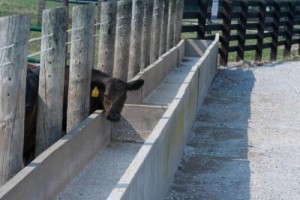Next cattle expansion will be complex
Posted on Jun 23, 2014“There has always been variation in cattle inventory from year to year,” said Kenny Burdine, agricultural economist with the University of Kentucky College of Agriculture, Food and Environment. “There was an upward trend from the 1930s to the 1970s, followed by a sharp and then more gradual reversal that has continued through today.”

PHOTO: Steve Patton, UK Agricultural Communications
So many factors play into the current situation, not the least of which is a massive, long-standing drought in the Southern Plains that has reduced conditions to a modern-day Dust Bowl. But that’s not the only thing affecting cattle numbers. Burdine said many things would determine when and if a cattle expansion occurs.
“There’s really no single factor that drives a producer to decide to expand or reduce their cow herd size,” he said. “Producers respond to a wide array of market signals, and they operate within a wide range of constraints as well. Regardless, I believe the next expansion is going to be very complex.”
Even though Kentucky has not experienced the same harsh drought conditions as the Southern Plains in the past couple years, drought was an issue in 2007, 2008 and 2012. Kentucky’s cattle inventory has decreased by about 195,000 cows since 2007 according to the U.S. Department of Agriculture. According to fellow UK agricultural economist Greg Halich, however, conversion of pasture ground to row crops is probably the main reason for the reduced numbers in Kentucky.
“Record prices and profitability in row crops has led to this conversion, and most of this ground will not come back to pasture very easily,” he said.
As corn and soybeans gained popularity for their profitability in the past several years, cattle producers opted for row crops over cow numbers. If grain prices decrease and grain profitability declines, producers may start to convert row crops back to pasture and increase their herds again.
“That really just illustrates a basic economic principle that farmers are going to allocate their land to what is going to be most profitable for them,” Halich said. “Cattle obviously compete with other land uses. In Kentucky, we’ve historically run cattle and produced hay on ground that is also suitable for row crop production, particularly in the central part of the state.”
It’s easier to convert pasture to row crops than to convert row crops to pastureland. Halich said it’s not really that simple to “switch” back. Re-establishing forages takes time. And then there are the fences that many farmers removed to make row crop management more efficient.
“Once those fences are gone, the cost of returning the land to pasture dramatically increases,” he added. “Fencing is very expensive, and producers will only make that investment when it is justified by the market.”
Burdine explained that there are many areas that were forced to reduce numbers because of weather, and they will want to expand again once weather conditions improve. In Texas, beef cow numbers have decreased 22 percent since 2011 and much of that land is not well suited to row crop production.
It’s important to note that producers don’t just automatically expand when prices reach a certain level.
“It’s true, calf and feeder prices are at an all-time high,” Burdine said. “It’s also true that production costs have dramatically gone up as well. To really signal an expansion, prices will have to rise enough to translate into increased profits at the cow-calf level.”
When it does come about, expansion could actually happen pretty quickly in the early stages. Heifer retention gets a lot of attention in expansion talks.
“We’ve actually seen increased heifer retention over the past several years,” Burdine said. “But, this hasn’t really been enough to offset the reduction in beef cow numbers brought about by higher than normal culling.”
Expansion is a long-term process that involves cattle that are likely to remain in production for 10 years or more. A producer who purchases additional bred heifers, or one who holds back their own heifers, makes an investment that requires several years to pay back. The upfront cost is high, and producers don’t know what the conditions will be throughout the time it takes to recover the investment. Those long-term profit expectations are what most farmers are using to guide their expansion decisions.
Burdine and Halich also asked the question, “Do farmers and ranchers really have to expand the herd?”
“It’s assumed that there are folks out there ready to expand when conditions are better,” Halich said. “But there is a growing concern that fewer and fewer of the next generation are willing to take up the challenges and opportunities of raising cattle. Fewer cattle farmers coming up through the ranks and a decrease in large tracts of land suitable for cattle will make it more difficult to expand the cattle herd in the future.”
Press release courtesy of UK CAFE
Comments